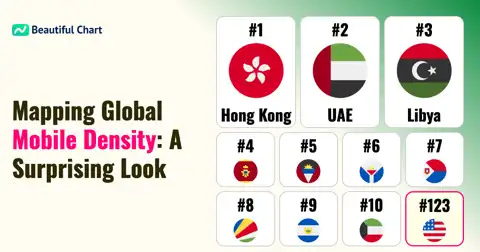This chart compares the GDP of Japan and African countries from 1980 to 2024. It visually presents the economic growth of Japan and the economic development trends of African nations. The chart highlights the economic disparities between Japan and African countries.
GDP (Gross Domestic Product) represents the total value of all goods and services produced within a country over a specific period, serving as a crucial indicator of the nation's economic size.
1980s
In the 1980s, Japan's GDP showed a steady increase. In 1980, Japan's GDP was $1,129.38 billion, driven primarily by the electronics and automotive industries. In contrast, among African countries, South Africa had the highest GDP at $89.41 billion, relying on its mining industry for gold and diamonds.
In 1981, Japan's GDP increased to $1,245.24 billion, and South Africa's GDP slightly rose to $93.15 billion. During this period, Japan's economic growth was fueled by technological innovation and the growth of the manufacturing sector. Another significant African country was Algeria, with a GDP of $48.16 billion, driven by the oil and gas industry.
By 1983, Japan's GDP reached $1,270.86 billion, and South Africa's GDP was $96.21 billion. Algeria's GDP was $51.58 billion, still reliant on its resource-based economy. Libya, with a GDP of $32.99 billion in 1983, also depended heavily on oil exports.
1990s
In 1990, Japan's GDP increased to $3,185.91 billion. During this time, Japan experienced a temporary economic boom due to its bubble economy, but this was followed by a prolonged economic downturn after the bubble burst. South Africa's GDP was $126.03 billion, undergoing economic restructuring due to the end of apartheid and political changes.
In 1995, Japan's GDP was $5,545.56 billion, and South Africa's GDP was $171.74 billion. Japan implemented various economic policies to recover from the bubble burst, while South Africa pursued economic reforms post-democratization. Nigeria also played a significant role during this period, with a GDP of $132.23 billion, primarily driven by the oil industry.
By 1999, Japan's GDP had declined to $4,635.98 billion, and South Africa's GDP was $151.43 billion. Japan struggled with a long-term recession, whereas South Africa's stable political environment facilitated economic growth. Egypt's GDP in this period was $95.04 billion, benefiting from tourism and Suez Canal revenues.
2000s
In 2000, Japan's GDP was $4,968.36 billion, and South Africa's GDP was $151.86 billion. Japan sought to recover its economy through the growth of the information technology and service industries, while South Africa focused on expanding international trade and attracting foreign investment. Nigeria's GDP in 2000 was $67.82 billion, driven by oil exports.
By 2005, Japan's GDP was $4,831.47 billion, and South Africa's GDP had risen to $288.75 billion. Japan continued to face challenges in economic recovery, but South Africa benefited from large infrastructure investments in preparation for the 2010 World Cup. Algeria's GDP in 2005 was $107.05 billion, supported by the energy sector.
In 2008, Japan's GDP increased to $5,106.79 billion, and South Africa's GDP was $316.49 billion. Despite being impacted by the global financial crisis, Japan continued its growth, while South Africa maintained relatively stable economic growth. Angola had a GDP of $88.54 billion in 2008, heavily reliant on oil exports.
2010s
In 2010, Japan's GDP was $5,759.07 billion, and South Africa's GDP was $417.31 billion. Japan attempted to recover through significant fiscal policies and economic reforms, while South Africa sustained economic growth through the resource sector and increased foreign investments. Egypt had a GDP of $230.24 billion in 2010, with tourism and Suez Canal revenues contributing to its growth.
By 2015, Japan's GDP was $4,444.93 billion, and South Africa's GDP was $346.66 billion. Japan aimed for economic growth through a weaker yen and increased exports, whereas South Africa maintained its economy despite political instability by continuing resource exports. Nigeria recorded a GDP of $492.44 billion in 2015, largely driven by the oil industry.
In 2019, Japan's GDP was $5,179.95 billion, and South Africa's GDP was $389.25 billion. Japan achieved stable economic growth, while South Africa focused on economic reforms and attracting foreign investment. Kenya had a GDP of $100.33 billion, with agriculture and service industries driving its economy.
2020s
In 2020, Japan's GDP was $5,050.57 billion, and South Africa's GDP was $338.19 billion. Both countries were significantly impacted by the COVID-19 pandemic, which caused economic setbacks. Egypt's GDP in 2020 was $382.53 billion, maintaining growth despite the pandemic's impact on the tourism industry.
By 2023, Japan's GDP was $4,212.94 billion, and South Africa's GDP was $377.68 billion. Japan implemented various policies for economic recovery post-pandemic, and South Africa achieved economic growth through political stability and the recovery of the resource sector. Ethiopia had a GDP of $159.75 billion in 2023, with agriculture and manufacturing contributing to its economic development.
The GDP analysis of African countries and Japan reveals that economic changes were significantly influenced by industrial structures, political stability, international trade, and investment. Japan achieved economic growth through technological innovation and industrialization but faced long-term recessions due to the bubble economy. South Africa underwent economic restructuring due to political changes and resource-based industries. Other significant African countries, such as Egypt, Nigeria, Kenya, and Ethiopia, each pursued economic growth based on their unique industrial and political circumstances. Both regions have made various efforts to recover economically post-pandemic.
| Rank | Name | Indicator |
|---|---|---|
1 | $ 4T 110B | |
2 | $ 373B 233M | |
3 | $ 347B 594M | |
4 | $ 266B 779M | |
5 | $ 252B 738M | |
6 | $ 205B 130M | |
7 | $ 152B 377M | |
8 | $ 104B 1M | |
9 | $ 92B 123M | |
10 | $ 86B 911M | |
11 | $ 79B 605M | |
12 | $ 75B 244M | |
13 | $ 73B 761M | |
14 | $ 56B 310M | |
15 | $ 54B 708M | |
16 | $ 53B 205M | |
17 | $ 48B 221M | |
18 | $ 35B 450M | |
19 | $ 34B 405M | |
20 | $ 29B 872M |





